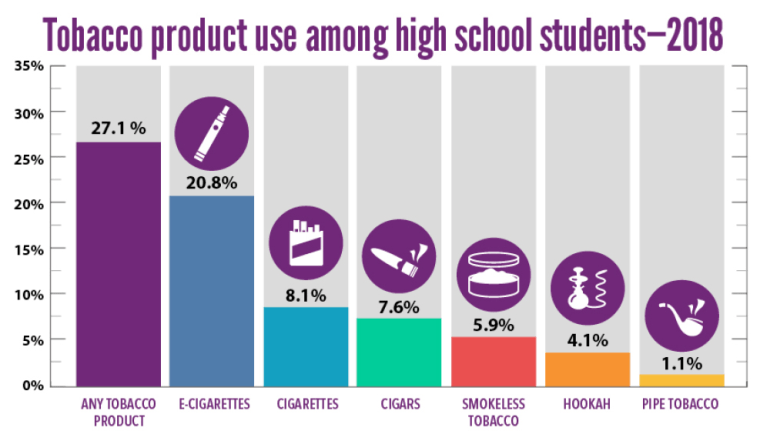Tobacco use among American high schoolers grew more than 38 percent last year from 2017, the government said in a report published Monday that blamed e-cigarettes for single-handedly erasing progress in keeping young people off the addictive drug. Among middle school students, the increase — 28.6 percent — was equally sobering.
The report, from the Centers for Disease Control and Prevention, said that overall last year, more than one in four high schoolers and about one in 14 middle schoolers reported using a tobacco product in the previous 30 days — 4.9 million kids in total. In 2018, e-cigs were still the most commonly used tobacco product among teens.
"It’s putting a new generation at risk for nicotine addiction,” Dr. Robert R. Redfield, the CDC's director, said in a news release. "Youth use of any tobacco product, including e-cigarettes, is unsafe.”
The report said that in 2018, 20.8 percent of those in ninth to 12th grades said they vaped, up from 11.7 percent in 2017, a 78 percent increase. The percentage of sixth- to eighth-graders who said they vaped went from 3.3 percent to 4.9 percent, a 48.5 percent increase. However, there was no significant change in the use of other tobacco products, including cigarettes, during that time among either group.
The data was gathered from the National Youth Tobacco Survey, an annual poll of American students that asks about their use of cigarettes, cigars, e-cigs and four other tobacco products.
People who work to stop kids from smoking — such as Brian King, a deputy director with the CDC's Office on Smoking and Health — lamented the dour statistics. "That progress that we've made over the past years has been completely erased," he told NBC News. "And it's a primary result of e-cigarettes."
E-cigarettes are battery-operated devices that heat up liquid nicotine; users inhale the vapor that is produced. Smoking e-cigs is more discreet than smoking cigarettes, which makes it appealing to teenagers.
The version sold by one manufacturer, Juul, is especially popular with teens because the nicotine cartridge, which resembles a flash drive, can be recharged on a laptop and is easily concealed. It also comes in fruity and sweet flavors that kids like, King said. Juul has said its e-cigs are intended only for adult smokers who want to move to safer products.
King said cigarette smoking had been declining among American youth since around 1998. "However within the past three years, we have not seen any change in cigarette smoking," he said, adding that it had been hovering around 8 percent. "We're certainly not seeing any progress when it comes to e-cigarettes."
"What we ultimately don't want to do when it comes to tobacco product use is play a game of whack-a-mole," King said, "where we're allowing certain products to go down, and certain products to go up. When it comes to youth, there's no redeeming aspects of any form of tobacco product, whether it's smoked, smokeless or electronic."

Anti-tobacco organizations called the report troubling.
"These results are strong evidence that e-cigarettes are not helping to drive down youth cigarette use," Matthew Myers, president of the Campaign for Tobacco-Free Kids, said in a statement. "Indeed, if anything, the evidence to date indicates that e-cigarettes could increase the number of kids who smoke cigarettes."
In November, the Food and Drug Administration proposed a ban on menthol cigarettes and flavored cigars, but exempted menthol and mint-flavored e-cigarettes from any proposed restrictions, reasoning that the flavors may be important for adults trying to quit smoking. But Myers called on the FDA to ban those two flavors because the 2018 student tobacco survey found that more than half of all high school e-cigarette users favored them.
Robin Koval, CEO and president of the Truth Initiative, an anti-smoking organization, said in a statement that the data revealed a "disturbing link" between youthful e-cigarette use and a progression to cigarette smoking.
"This is a public health emergency that cannot be ignored," she said.


